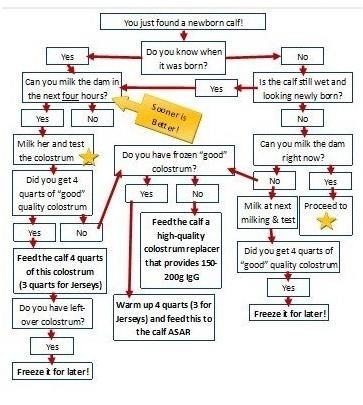By Cassie Yost and Hayley R. Springer
Colostrum is the best way to protect young calves from disease. This helps ensure heifer calves will survive to join your milking herd and be the most productive animals they can be when they get there. We often hear the "rules" of colostrum being to get fresh colostrum from the calf’s dam into the newborn calf within two hours of birth. To achieve this goal for every calf born really requires round-the-clock monitoring of the herd. For the small dairy, this is often just not possible. Despite this, good colostrum management can still be achieved on the small dairy that's willing to make colostrum a priority.
Give Every Calf the Best Colostrum You Can Provide!
Don't take the risk of feeding colostrum of unknown quality.
All colostrum should be tested, and only colostrum reading "good" on a colostrometer or over a BRIX score of 22 percent on a refractometer should be fed to newborn calves. Lower-quality colostrum can be used for the calf 's second feeding or later.
Milk the dam as soon after birth as is practical for your farm.
Colostrum is formed largely before calving. After calving, the cow quickly transitions to milk. The longer we wait to harvest colostrum, the more it is diluted with regular milk.
If you have more "good" colostrum than you need today, keep it for another day.
Colostrum lasts for two to three days in the refrigerator or six months in the freezer. Be sure to label stored colostrum with the dam's ID, the date, and the colostrum's quality. To extend the time colostrum can be refrigerated to seven days, potassium sorbate can be added.
Make the Newest Addition to Your Herd Your Priority!
Feed every calf as soon as possible after birth, even if it is not convenient.
Feeding colostrum within two hours of birth is ideal, but feeding it within eight hours is critical. Make feeding colostrum the first thing you do, especially in the morning when you may not know when a calf was born.
Give each calf enough colostrum to ensure they will be protected.
It is recommended to feed 10 percent of the calf 's body weight in colostrum. This typically works out to 4 quarts for a Holstein and 3 quarts for a Jersey. While it's true that they may not be hungry for a while after feeding, the colostrum fuels the calf, its immune system, and your herd's future.
Colostrum is critical, but don't forget about the navel.
Navel infections can lead to many other problems, so be sure to also dip the navel with a quality navel dip product when you feed colostrum.

Prepared by Dr. Hayley Springer, extension veterinarian, and Cassie Yost, extension dairy educator.
Source : psu.edu